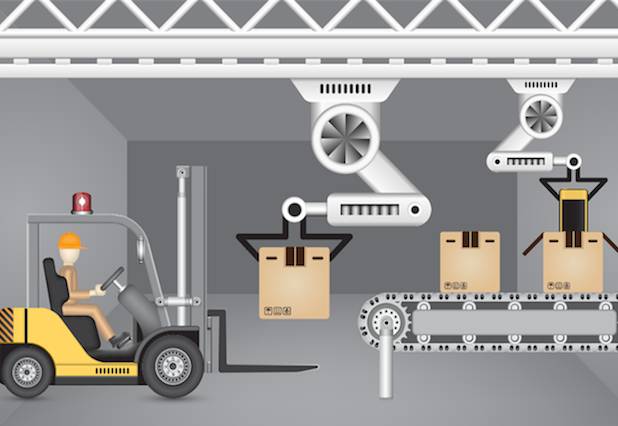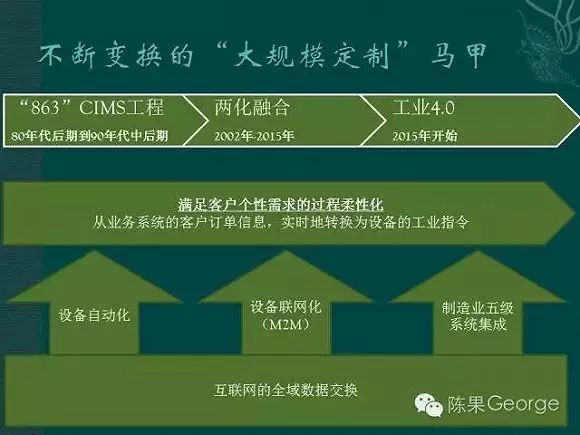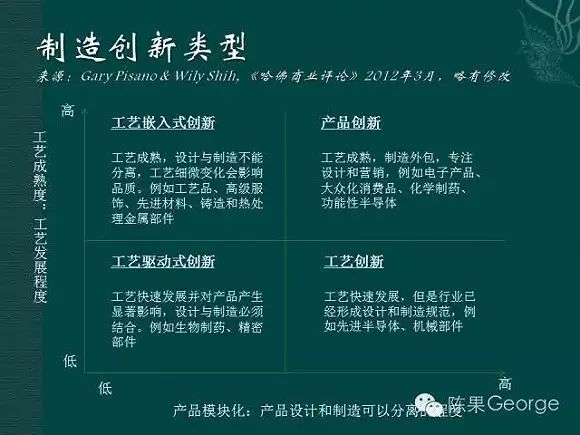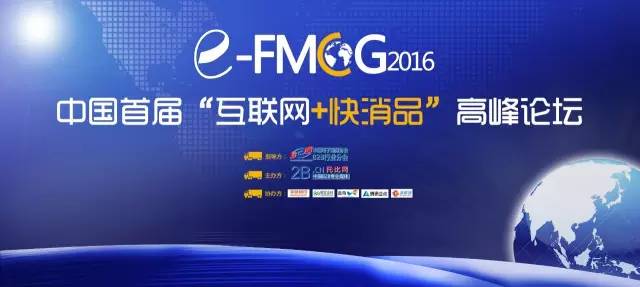Exciting content
The various “Industry 4.0” application cases boasted by domestic media do not show any substantial innovation compared to the theory mentioned in the 1993 book “Mass Customization: The New Frontier of Competitive Advantage” and do not go beyond the scope of CIMS and the integration of IT and industrialization.

What is the essence of manufacturing? I believe manufacturing is the industry of “changing the shape of materials,” transforming steel, cotton, and quartz sand into cars, clothes, and chips through various means. The core capabilities of this industry are three:
-
The first is precision, mainly relying on process level, with secondary factors being worker capability and manufacturing equipment (manufacturing precision equipment itself is also a precision issue);
-
The second is efficiency, which involves cost, quality, and delivery speed, primarily a management issue;
-
The third is innovation, creating new utility to meet user needs, primarily a research and development investment issue.
Recently, the hot topic in China is “Industry 4.0,” which is part of the “Made in China 2025” plan: to accelerate the transition from a manufacturing giant to a manufacturing power, promote technological transformation of traditional industries, resolve excess capacity, support corporate mergers and reorganizations, and promote deep integration of industrialization and informatization. Major projects will be implemented in high-end equipment, information networks, integrated circuits, new energy, new materials, biomedicine, aircraft engines, gas turbines, etc., nurturing a number of emerging industries into leading industries. An “Internet+” action plan will be formulated to promote mobile internet, cloud computing, big data, and the Internet of Things in conjunction with modern manufacturing, fostering the healthy development of e-commerce, industrial internet, and internet finance, guiding internet companies to expand into international markets. The state has established a 40 billion yuan venture capital guidance fund for emerging industries to support industrial innovation.
This paragraph mixes “goals” and “means,” so let me try to sort it out:
The goals of “Industry 4.0”: 1. Resolve excess capacity, 2. Enhance capabilities of high-end and emerging manufacturing industries.
The means of “Industry 4.0”: 1. Integration of IT and industrialization, 2. The platform and technology for this integration is the “Internet+”, 3. Through the Internet, industry connects with commerce and finance.
If this sorting aligns with the original intent, the question arises: can these means help the country achieve the two goals of transforming and upgrading its manufacturing industry?
I believe it cannot.
The core of “Industry 4.0” is “smart manufacturing,” with the means being “Internet of Things, industrial big data, cloud”—an upgraded version of the “integration of IT and industrialization,” which was earlier the CIMS of the “863 Program.”
Despite the so-called “Industry 4.0” adopting some quirky names, such as “Cyber-Physical Systems (CPS),” it is merely a rebranding of the corresponding business process data conversion (business network) based on industrial automation and device data exchange (industrial network). It’s just a new name.
Although the concepts of the Internet of Things, big data, and cloud computing have some novelty, and the technical standards and solutions are indeed evolving, I believe that the various “Industry 4.0” application cases touted by domestic media do not show any substantial innovation compared to the 1993 book “Mass Customization: The New Frontier of Competitive Advantage” and do not go beyond the scope of CIMS and the integration of IT and industrialization.

1. Equipment automation: Add data collection and control chips to equipment or products. When I was in elementary school, my father was already working on data collection systems for Z80 single-board computer production lines. Over ten years ago, Shanghai newspapers reported that SAP intended to implant RFID chips in every quarantine-processed piece of pork in Shanghai, which is now called the “Internet of Things”;
2. Equipment networking: Industrial Ethernet and industrial real-time databases are not new either. In 2001, I took a senior executive from Sany Heavy Industry to visit the newly built Shanghai General Motors plant, where the factory had already deployed a wireless network in the workshop, with production instructions transmitted directly from the central system to each position, even to logistics machinery like forklifts. The flexible mixed-flow production line left the Sany executive envious, but this technology now lacks much novelty, and some people label it as “cloud”;
3. Five-level system integration: Baosteel was already working on five-level system integration 20 years ago. Around 2006, seizing the opportunity of the rapid development in the domestic steel and metallurgy industries, I implemented several “thick three, thin four; thick four, thin three” schemes, integrating commercial data (ERP) and industrial data (MES/DCS). Analyzing the commercial rules of products used to be rule-driven, and in terms of data mining, the steel industry has long used industrial data from steelmaking for “steelmaking model” analysis to optimize yield. Now, people label this as “big data”;
4. Internet-based global data exchange: Based on the Internet, machines can communicate with each other, and information exchange occurs between different enterprises, allowing machines to communicate with machines, people with people, and people with machines. This method of data exchange has evolved from EDI to XML, and during the last internet bubble, the once-popular RosettaNet and UDDI services (if you don’t understand this impressive term, please Google it; I attempted to develop a UDDI node for the automotive manufacturing industry in China back in 2000). The technology is fundamentally not an issue; over ten years ago, everyone was fantasizing about globalized manufacturing “communism,” but this B2B concept collapsed with the internet bubble.
In fact, technological innovation has its industrialization cycle, and the constant hype about the informatization of manufacturing is not unreasonable. However, once “Industry 4.0” is brought up as a topic, it inevitably raises concerns. Industry 4.0 was proposed by Germany, a manufacturing powerhouse, as a government-led initiative with companies like Siemens, Bosch, and SAP taking the lead. It is clear that this is not market-driven, as consumer/customer demand for personalized manufacturing was identified over 20 years ago by Joseph Pine in his works “Mass Customization: The New Frontier of Competitive Advantage” and “The Experience Economy.” The market environment has not changed significantly; it is the manufacturers, particularly IT companies like those in the internet and AI sectors, that are driving a topic that the manufacturing industry has already practiced for 30 years.
Addressing the real issues in Chinese manufacturing—excess capacity and insufficient high-end equipment manufacturing capabilities—has almost no logical connection to “Industry 4.0.” Some decision-makers think about how the internet can disrupt manufacturing, but their analogy is akin to Taobao disrupting Armani, or a video live streamer replacing the Louvre.
In this article, I initially proposed the three essences of manufacturing; “Industry 4.0” may only help enhance the second core capability, which is the efficiency of responding to customer demands. Regarding the innovation model in manufacturing, the following model reflects how leading industrial countries like the US are thinking about reviving their manufacturing sectors. High-end manufacturing is returning to the US, not only due to domestic political factors but also due to a change in the dependency model of research and manufacturing.

This model is also helpful for thinking about Chinese manufacturing. The two areas of process and product innovation are what Chinese manufacturing truly needs to address in the post-industrial era, rather than commercial model innovations like “Industry 4.0.”
In the past 20 years of rapid growth, we have relied on investment-driven growth and comparative labor cost advantages to gain international industrial outsourcing. The effectiveness of development is also inseparable from the efficient support of the government. The rapid industrialization of society has allowed people to enjoy the dividends of reform. The current root cause of the problems is:
A. Resolving excess capacity: I believe that excess capacity cannot be generalized. The low-end processing industry’s capacity, which is labor-intensive, results from international industrial outsourcing. As labor costs rise and competitiveness declines, this is a “sweet trouble” for social development. Transferring low-end processing labor to the service sector can effectively resolve this issue; while excess capacity in large industries is a legacy of over-investment. Investment-driven economic growth is a pattern that also occurred during the industrialization of Europe in the late 19th century. Until before World War II, global colonialism absorbed a large amount of capacity. For China, the times have changed; opportunities in the “Belt and Road” initiative and regions like sub-Saharan Africa and South America depend on international political strength and wisdom.
B. High-end manufacturing: High-end manufacturing can be divided into two situations.
One is consumer-grade product manufacturing, which does not mean companies lack R&D and manufacturing capabilities, but rather that they lack motivation. I have previously commented on the phenomenon of Japanese toilet seats; the high quality of consumer goods is not unique to Japan and Germany, but is a characteristic of all post-industrial countries. The quality of products in the US, UK, and France is equally excellent, and superior quality is an inevitable result of social transformation. The exceptional quality of Japan and Germany is mainly because these two countries have the oldest populations in the world (with average ages exceeding 46 years). The combination of wealth accumulation and aging population inevitably leads to personalized demand in a limited market.
In the rapidly growing Chinese market, the focus is on the weight rather than the quality of entrepreneurs, which is a rational choice for this stage. In the future, as the middle class in China expands, the upgrade of consumer product manufacturing will occur naturally.
The second is industrial-grade products and precision manufacturing, which rely on the inheritance of national culture and the accumulation of technological strength. Europe and the US have a tradition of engineering. Visiting the British Railway Museum, I was struck by the design and manufacturing capabilities of the British over a century ago. Only upon viewing the Warehouse would one discover the substantial accumulation behind it. To be honest, if someone takes pride in ancient Chinese architectural levels, I would suggest they explore the churches of Europe; the accumulation of core technologies in gas turbines, nuclear power plants, and high-speed rail is a reconstruction of the entire nation. Some might ask why China cannot produce single-lens reflex cameras; I would then ask why Australia cannot produce single-lens reflex cameras either. Why are only Germany and Japan major countries in precision optics? Let’s not forget that these two countries mobilized national resources for war.
We should stop blindly following concepts, especially the hype around the internet, and instead work on solving real problems.
I believe the starting points for the transformation and upgrading of China’s manufacturing industry are:
1. Industrial chain construction: Manufacturing, especially large industries, is an industry with a very long industrial chain. Product improvement not only depends on brand merchants that shine on the public stage, but also largely relies on the R&D and manufacturing capabilities of parts and components, including the application of new materials, metal processing, and electromechanical integration technology. The government should invest significant efforts in industrial planning, building industrial commons and clusters to stimulate innovation vitality in the upstream of the industrial chain;
2. Talent cultivation: The biggest deficiency in manufacturing is education, whether for technical personnel or skilled workers. The excessive capitalization of recent years has harmed the growth environment and dedication system for manufacturing talent;
3. Intellectual property protection: In advancing the economy, the most significant contributions should come from the legal system, and the issue of intellectual property is the greatest barrier to the lack of progress in China’s manufacturing industry.
These three points reach the essence of manufacturing; let’s talk less about “Industry 4.0.”
 ↙ Click the bottom to read the original article and register for the conference
↙ Click the bottom to read the original article and register for the conference